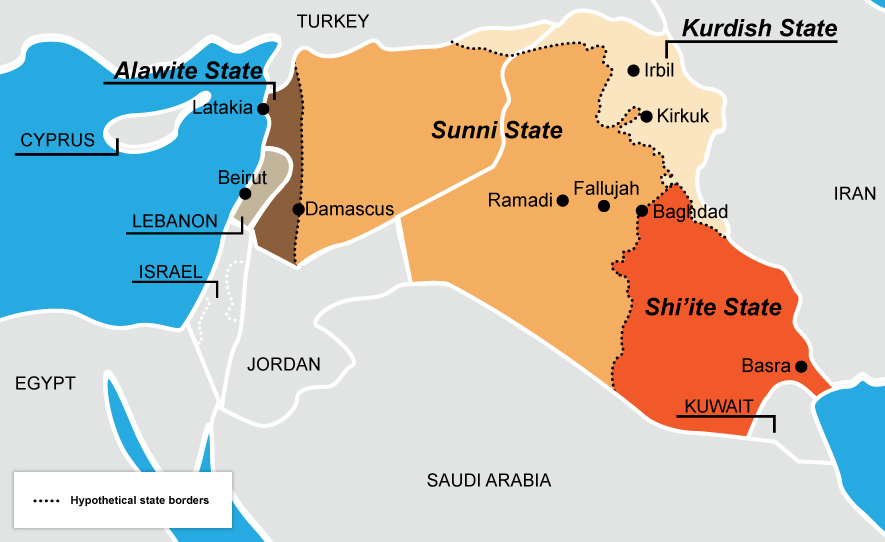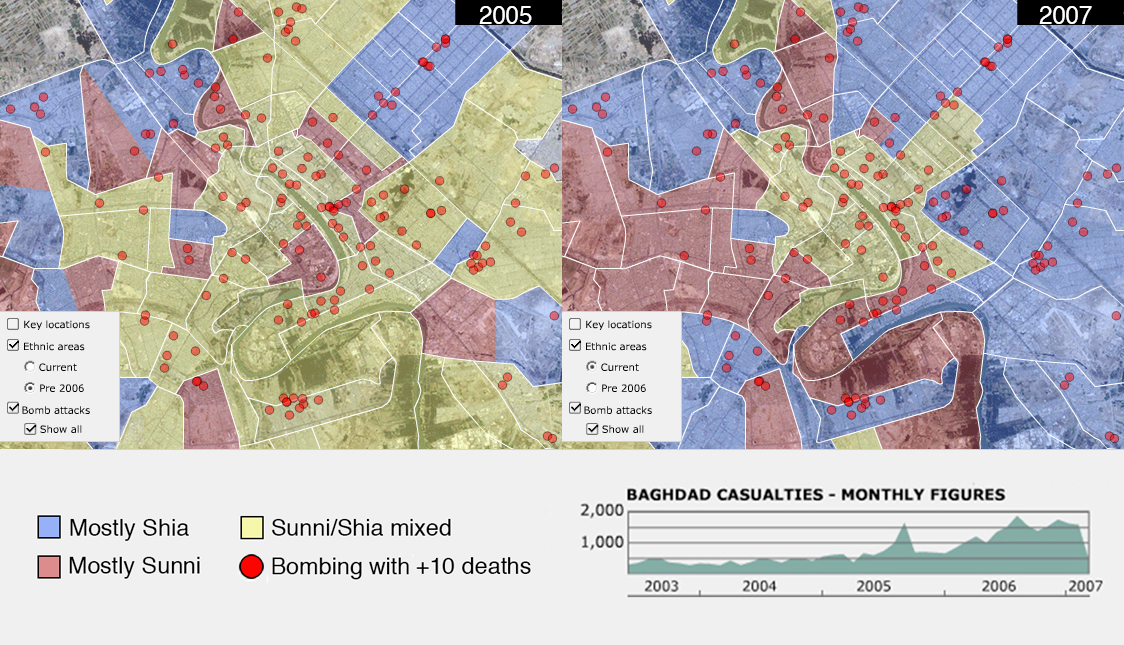BEFORE UNDERSTANDING THE “ISIS” we need to understand IRAQ
region , itz history ,the Saddam Hussein Government nd so on !!!
Iraq's demographic divide
- Iraq's three-way demographic divide didn't cause the current crisis, but it's a huge part of it. You can see there are three main groups.
- The most important are Iraq's Shia Arabs (Shiiism is a major branch of Islam), who are the country's majority and live mostly in the south.
- In the north and west are Sunni Arabs. Baghdad is mixed Sunni and Shia.
- And in the far north are ethnic Kurds, who are religiously Sunni, but their ethnicity divides them from Arab Sunnis.
- Iraq's government is dominated by the Shia majority and has underserved Sunni Arabs; the extremist group that has taken over much of the country, ISIS, is Sunni Arab.
- Meanwhile, the Kurds, who suffered horrifically under Saddam Hussein, have exploited the recent crisis to grant themselves greater autonomy.
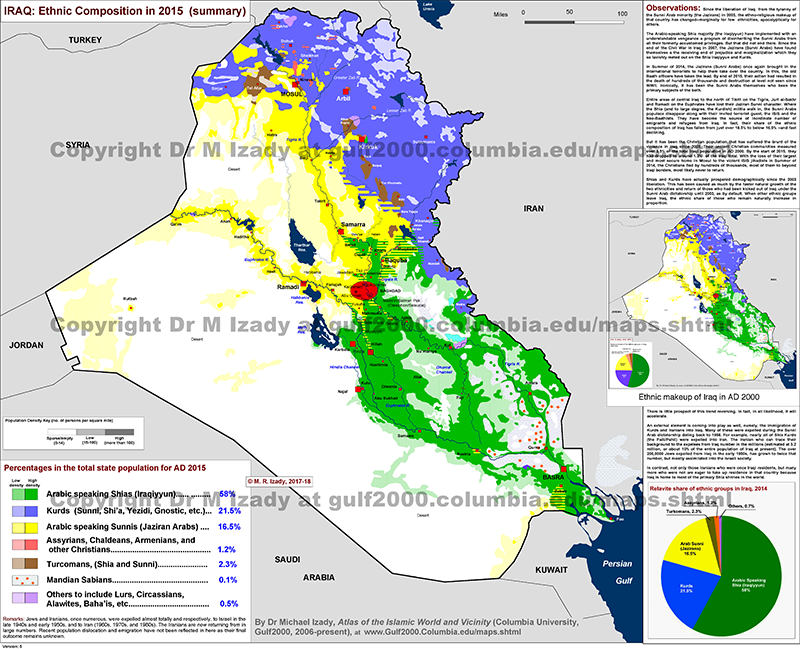

Sunni-Shia balance in the Middle East
- This map of the region's Sunnis and Shias is crucial for understanding the larger geopolitics of the Iraq crisis and how its neighbors are responding.
- Look at the swath of mostly-Sunni territory in northern Iraq and eastern Syria, both countries that are led by Shia-dominated governments; a lot of that grey area is under ISIS control.
- While no one in the Middle East is happy about ISIS's takeover, the Shia governments are responding most forcefully, and the crisis is giving common cause to the Shia governments of Syria, Iraq, and Iran.
- This could exacerbate already-bad tension between the region's Sunni and Shia powers, which have been supporting opposing sides in the Syrian civil war.
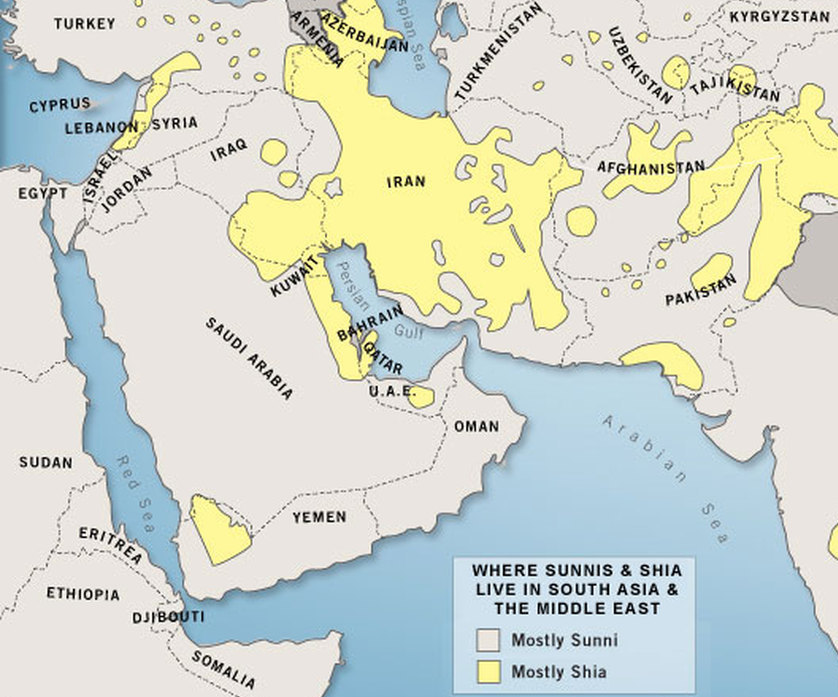
The Kurdish region, in Iraq and beyond
- The Kurds — who are long-oppressed minorities in Iraq, Syria, Turkey, and Iran — have been fighting for their own country for more than a century.
- They've come closest in Iraq, where, since the 2003 war, the international community has pushed to give them an unprecedented degree of autonomy.
- Since the recent crisis began, they've taken even more de facto autonomy for themselves, and recently seized control of the oil-rich area around Kirkuk, which is part Arab and part Kurd.
- The big problem for Kurds is that all of Iraq's neighbors want to prevent an independent Iraqi Kurdish state, because they fear their own Kurdish populations will then fight to break off and join them.


Iraq's enormous oil reserves
- Iraq has the fifth largest proven oil reserves of any country, after Venezuela, Saudi Arabia, Canada, and Iran.
- Production has gone up since the fall of the Hussein regime; in February 2014, 3.6 million barrels were being pumped a day, while in 2002 about 2 million were pumped a day.
- In 1991, following the Gulf War, a mere 305,000 barrels were pumped a day, gradually picking up as the country recovered from its defeat.
- The oil is concentrated in the Shia south and Kurdish north, with Sunni regions to the west notably lacking in oil wealth.
- That makes it all the more significant that the Sunni ISIS rebels have targeted the country's largest oil refinery and have suggested they plan on seizing much of the country's northern oil fields; see the map of "ISIS's 2006 plan for Iraq and Syria" below for more on that.
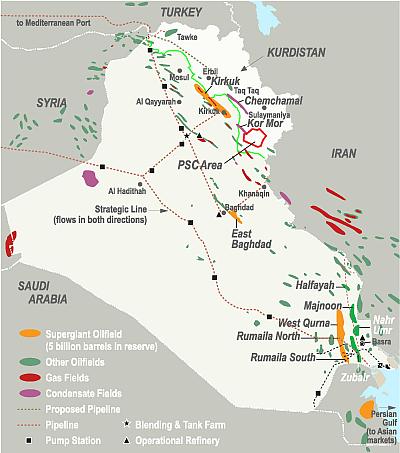 |
History of Iraq
The Battle of Karbala, 680 AD
- Sunnis and Shias have gotten along fine for most of Islam's history, but the Syria and Iraq crises are driving them apart today, and it helps to understand the historical roots of how Islam split along these two major branches and what it has to do with Iraq.
- In the 7th century, soon after the Prophet Mohammed who founded Islam died, there was a dispute over who should succeed him in ruling the vast Caliphate he'd established.
- Some wanted to elect a successor, while some argued power should go by divide birthright to Mohammed's son-in-law, Ali.
- The dispute became a civil war, the divide of which began today's Shia (the Partisans of Ali, or Shi'atu Ali, hence Shia) and Sunni. Ali was killed in the city of Kufa, in present-day Iraq. 20 years later, his followers traveled with Ali's son Hussein from Islam's center in Mecca up to Karbala, which is in present-day Iraq, where they were killed in battle and the war ended. Their pilgrimage is mapped here; it made Kufa and Karbala, and other locations in southern Iraq, the heartland of Shia Islam.


The Safavid Empire at its height
- Almost a thousand years after Ali and Hussein's deaths, the Persian Safavid Empire (today we would call it Iran) expanded to conquer much of eastern Iraq.
- This is still a source of distrust between the Arabs of Iraq and the Persians of Iran, and reinforces a belief that the much-larger Iran seeks to conquer or control Iraq.
- This is important for remembering that Iraqi Shia might share a religion with Iranians, but they're still wary of Iran.
- But it's an even bigger issue for Iraqi Sunnis, who sometimes believe that Iraqi Shia are secret pawns of Iran and will refer to Iraqi Shia as "Safavids."
- The worse the ISIS crisis gets, the more Iraq's Shia government turns to Iran for help, and the more that Sunni Iraqis fear a Shia plot against them.


How the Sykes-Picot agreement carved Iraq's borders
- You hear a lot today about this 1916 treaty, in which the UK and French (and Russian) Empires secretly agreed to divide up the Ottoman Empire's last Mid-Eastern regions among themselves.
- Crucially, the borders between the French and British "zones" later became the borders between Iraq, Syria, and Jordan. Because those later-independent states had largely arbitrary borders that forced disparate ethnic and religious groups together, and because those groups are today in conflict with one another, Sykes-Picot is often cited as a cause of warfare and violence and extremism in the Middle East.
- Scholars are still debating this theory, which may be too simple to be true. But the point is that the vast Arab Sunni community across the Middle East's center was divided in half by the European-imposed Syria-Iraq border, then lumped in to artificial states with large Shia communities.


Saddam Hussein's Al-Anfal campaign against the Kurds
- In 1988, Iraqi leader Saddam Hussein used chemical weapons to kill tens of thousands of Iraqi Kurds in the country's north.
- The attacks — which he named the al-Anfal Campaign after an episode in the Koran — were meant to put down Kurdish rebels who were fighting for autonomy.
- Al-Anfal killed in just a few months an estimated 50,000 to 100,000 civilians, although Kurdish groups say it was closer to 180,000.
- While the genocide is most infamous for Saddam's use of chemical weapons, this map also shows the less-known but similarly brutal mass execution sites, where Kurdish families were slaughtered en masse, and resettlement camps.
- The US responded tepidly at the time — it was tilting toward Saddam in his ongoing war against Iran — but Al-Anfal later became a justification for international action against Iraq, and is a big part of why Iraqi Kurds were granted autonomy after Saddam was toppled in 2003.


The 1990 Gulf War order of battle
- On August 2, 1990, Iraq invaded its neighbor Kuwait following disputes about oil production, and installed a puppet regime to run the country.
- After several months of occupation, a UN-sanctioned international coalition led by the US used ground and air forces to forces Iraqi forces out.
- The ground campaign to push back the Iraqi invasion of Kuwait was surprisingly short, beginning with the advance of coalition forces from Saudi Arabia into both Kuwait and Iraq on February 24, 1991.
- Within days Iraqi forces were retreating, and on February 28, President George H.W. Bush declared a ceasefire. The air war, however, began on January 17, and was devoted to destroying the Iraqi air force, anti-aircraft facilities, command infrastructure, and other military targets.
- Iraq responded by launching missile attacks on both Israel and Saudi Arabia; while Israel was not involved in the conflict directly, Iraq hoped to draw it into armed conflict and convince other Arab states to abandon the coalition.
- Israel exercised restraint, however, and the Arab forces remained part of the coalition. On January 29, Iraq attacked the Saudi city of Khafji, but was driven back by Saudi, Qatari, and US military forces two days later.
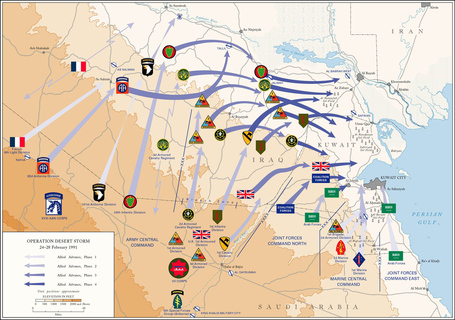

The anti-Saddam uprisings of 1991
- In March 1991, Saddam Hussein looked vulnerable to many Iraqis after his defeats in the Iran-Iraq War and in the Gulf War that had ended just weeks earlier.
- Kurdish rebels in the north and Shia Islamists in the south rose up in rebellion, among others, to oust Saddam.
- President Bush, who had thousands of troops stationed mere miles away, called on Iraqis to rise up. Many Iraqis believed the rebels would receive US military backing, but the support never came.
- While the rebels made large advances at first, particularly in the south, within a few weeks Saddam had defeated them and slaughtered thousands in reprisal killings.
- The episode left Iraq's opposition devastated, ultimately strengthening Saddam's hold. Many Iraqis who had risen up felt betrayed by the US and by Bush personally.
- Some American foreign policy officials and scholars also felt the US should have used the opportunity to push all the way to Baghdad and topple Saddam, a belief they advocated for years and finally carried into the George W. Bush administration a decade later, providing part of the ideological basis for the 2003 US-led invasion.

The no-fly zones imposed after the Gulf War
- After the Gulf War, the United States, France, and Britain set up "no-fly zones," in which Iraqi aircraft were forbidden to fly, in the northern tip and south of Iraq. The ostensible purpose of the zones were to protect the Kurdish and Shia populations from Iraqi air strikes after Saddam's massacres.
- In practice, this meant British and American aircraft patrolling Iraqi airspace continuously between the two Gulf Wars. The Iraqi military would frequently shoot at the international aircraft patrolling the zones, though they never shot down a manned plane.
- After Operation Desert Fox in 1998, when the US bombed Iraq ostensibly as punishment for not complying with UN weapons inspectors, the low-level conflict over the no-fly zone escalated. Saddam offered a reward to anyone who shot down an American or British plane, while the Western forces began regularly targeting Iraqi anti-air and other military emplacements. This all goes to show that the US military never really left Iraq — the no-fly zone only lifted just before the Coalition invasion began in 2003.
Why Saddam drained Iraq's marshes
- The marshes in southeastern Iraq weren't just a beautiful ecosystem; their bounty also fed 450,000 people by 1991.
- But after Shia insurgents began using them as a base to hide from goverment forces — one Iraqi called them "our Sherwood forest" — Saddam drained the water out of them.
- By diverting the flow of the Tigris and Euphrates river, Saddam deprived insurgents of a sanctuary. He also forced the so-called Marsh Arabs who lived nearby to flee; the population of the largest nearby city fell from 67,000 to 6,000 by 2003.
- Iraqi engineer Azzam Alwash led a movement to restore them after Saddam was desposed, but the Draining of the Marshes proves just how far Saddam was willing to go to more effectively kill his Shia opponents.

What sanctions did to Iraq
- During the period between the first and second Gulf War, the US and its allies enforced a containment policy against Iraq, and while military measures like no-fly zones (see above) played a role, the main mechanism was economic sanctions.
- UNICEF claimed that about half a million children died as a result. Then-UN ambassador Madeleine Albright, confronted with that figure, famously said, "we think the price is worth it."
- During the period between the first and second Gulf War, the US and its allies enforced a containment policy against Iraq, and while military measures like no-fly zones (see above) played a role, the main mechanism was economic sanctions.
- UNICEF claimed that about half a million children died as a result. Then-UN ambassador Madeleine Albright, confronted with that figure, famously said, "we think the price is worth it."
2003 invasion
The coalition against Iraq, 1990 and 2003
- While the United States was the prime contributor of troops to both the first Gulf War and the second, both were backed by international coalitions contributing troops, humanitarian aid, and other assistance.
- In 1991, that coalition was backed by a UN Security Council mandate and included among its ranks most of Western Europe (notably France and Germany) as well as several of Iraq's neighbors, like Syria, Egypt, and Saudi Arabia (which was actively threatened by Hussein's invasion of Kuwait, and was itself invaded by Iraq in the course of the war). As you can see in the above order of battle, French and Arab forces actively participated in the ground attack on Iraq.
- The 2003 invasion had no such consensus backing it. The UN Security Council declined to support the mission, with France and Germany opposed, and not a single Middle Eastern country expressed support. Only four countries — the US, UK, Poland, and Australia — participated in the initial invasion, and while others assisted in various capacities, it was nonetheless mostly an American and British operation.
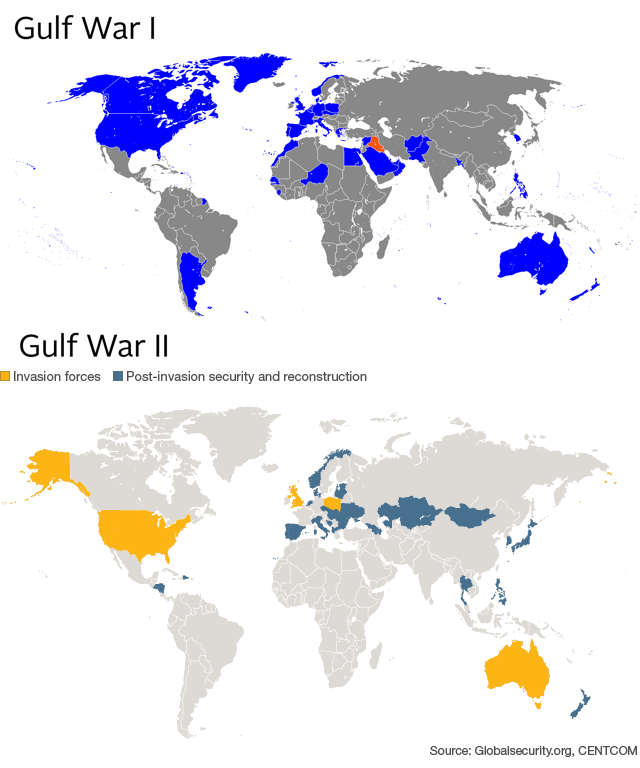
How the invasion overran Iraq in one month
- The invasion was mainly staged from Kuwait, with troops advancing northeast before reaching Baghdad in the second week of April.
- The ground advance was supplemented by air strikes, beginning in Baghdad at the Presidential Palace but escalating in scale as the invasion began in earnest.
- About a week into the invasion, the 173rd Airborne Brigade parachuted into northern Iraq and joined forces with Kurdish rebels, claiming the city of Kirkuk on April 10; American and Australian special forces were charged with securing the western portion of the country and preventing possible SCUD missile launches.
- Before the invasion, General Tommy Franks claims that the US, using a double agent, successfully tricked the Iraqi government into believing that the US would invade through Jordan, catching them off-guard when the actual invasion from Kuwait began.
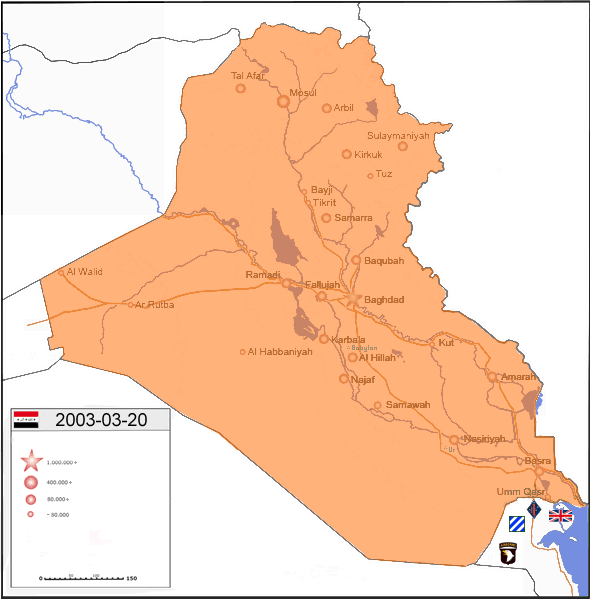
How de-Baathification devastated the Iraqi army
- In 2003, the US government essentially disbanded the Iraqi army. The plan was part of a policy called de-Baathification, the purpose of which was to cleanse the government of any influence from former members of Saddam's Baath Party so the ancien regime didn't reassert itself after its toppling.
- The problem with this plan is that a large number of recently unemployed Iraqi soldiers went and joined insurgent militias, greatly strengthening the anti-government forces while simultaneously stripping the government of its military capabilities.
- The effects of de-Baathification redound to this day: ISIS has become infinitely more skilled by incorporating skilled Saddam-era officers.
The rise and fall of the Sunni insurgency, 2006-2008
- ISIS was formerly known as al-Qaeda in Iraq (AQI). At its peak level of influence in 2006, AQI controlled significant chunks of Sunni Iraq, and even set up a quasi-government along harsh Islamic lines in some of the land it controlled.
- However, the Sunni population turned on AQI — partly out of anger with AQI's brutal rule and partly out of political interest.
- This Anbar Awakening, named after the province in which it began, resulted in former Sunni insurgents partnering with the American and Iraqi militaries to uproot AQI. AQI was roundly defeated, and lost effective control over almost all of its previous domain. The fall of AQI illustrates just how much ISIS depends on support from Sunni Iraqis. If it angers the population, they can provide critical intelligence and cooperation that would allow the Iraqi military to crush them.
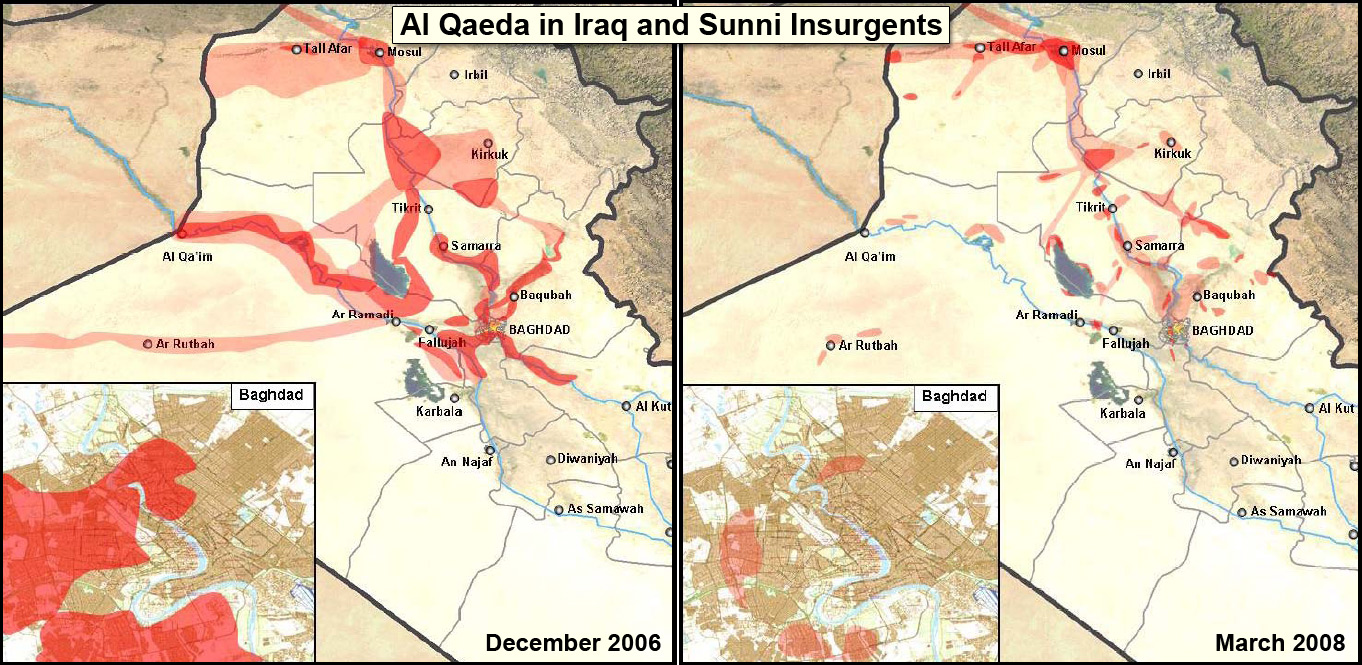
Iraqi civilian deaths, 2003-2010
No one suffered more from the Iraq War than Iraqi civilians. There are three distinct stages of the war.
- The first, from 2003 to 2005, was the war between the US-led invasion force and Iraqi forces, including government forces as well as Islamist and nationalist insurgents. Civilians in this period were bystanders.
- In early 2006, however, Iraq's conflict became what is often described as a civil war, fought among three factions: Sunni insurgents, including Islamist extremists and former Saddam loyalists; Shia militias, some of them rogue members of state security forces; and the US-led occupation force. In this period, which lasted two awful years, civilians were often the target of the violence, with bombings and death squads seeking to ethnically cleanse Baghdad in particular.
- While conditions improved significantly after 2008, many fear that the current crisis could reignite the sectarian hatreds and militias of 2006 to 2007.
The ethnic cleansing of Baghdad
- There are few grimmer symbols for the devastation of the Iraq War than what it did to Baghdad's once-diverse neighborhoods. The map on the left shows the city's religious make-up in 2005.
- Mixed neighborhoods, then the norm, are in yellow. The map on right shows what it looked like by 2007, after two awful years of Sunni-Shia killing: bombings (shown with red dots), death squads, and militias.
- Coerced evictions and thousands of deaths effectively cleansed neighborhoods, to be mostly Shia (blue) or mostly Sunni (red). Since late 2012, the sectarian civil war has ramped back up, in Baghdad and nationwide.
The current crisis
ISIS's 2006 plan for Iraq and Syria
- This map is hypothetical, but the fact that it exists at all speaks to ISIS's ambition. Aaron Zelin, an analyst at the Washington Institute for Near East Policy, found this 2006 map produced by ISIS, showing the areas it hoped to control and overlapping oil sources. The correctness of the map aside (there is not actually much oil in this area, despite the little derrick icons), it shows that the group has been thinking about the economics of its war and how to self-fund. It currently controls much of this desired territory, and some reports indicate ISIS has enough some oil production and refinery facilities, a big step toward being able to fund its own war.
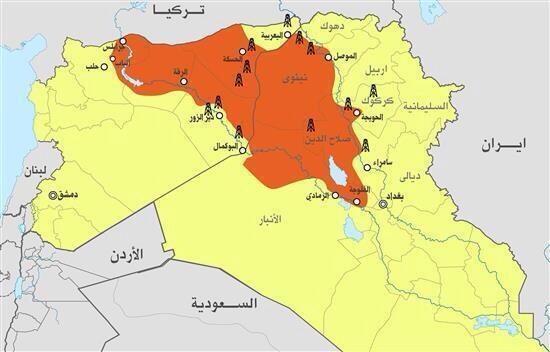

The Sunni protest movement of 2013
- Iraqi Prime Minister Nouri al-Maliki did a lot to assist in ISIS's rise. Since becoming Prime Minister in 2006, he has centralized a great deal of power in his office, and run the Iraqi government along Shia sectarian lines.
- Naturally, this infuriated Sunnis, who organized a series of protests around the country in 2012. These continued into 2013, and the Maliki government began to see them as a serious problem.
- Unable or unwilling to resolve the protests politically, the Maliki government turned to force. His security forces killed 56 people at protest in the northern town Hawija alone in April 2013. The forcible breakup of the protest movement convinced some Sunnis that their only solution was military, helping militant groups like ISIS and the more secular Jaysh Rijal al-Tariqa al-Naqshbandia (JRTN) recruit from and curry favor with the Sunni minority.
Syria's civil war
- This map shows the state of play in Syria's civil war, which after three years of fighting has divided between government forces (red), the anti-government rebels who began as pro-democracy protestors (green), Kurdish rebels (yellow), and the Islamist extremist fighters who have been moving in over the last two years (blue).
- Areas under government control tend to overlap with religious minorities, whereas both kinds of rebels are mostly from the Sunni Muslim majority. This is crucal for understanding the Iraq crisis because ISIS spent a year fighting and winning territory in Syria before it opened its offensive in Iraq. ISIS fighters have been in many cases fighting with and overpowering the more moderate rebels. This has happened in part because extremists have received funding from Gulf countries, in part because they are better at attracting foreign fighters, and in part because Syria's government has refused to target ISIS, correctly believing that foreign powers like the US may hate Assad but would ultimately prefer him to ISIS. All of that helped give ISIS a staging ground, territory, and battlefield training for its assault now.
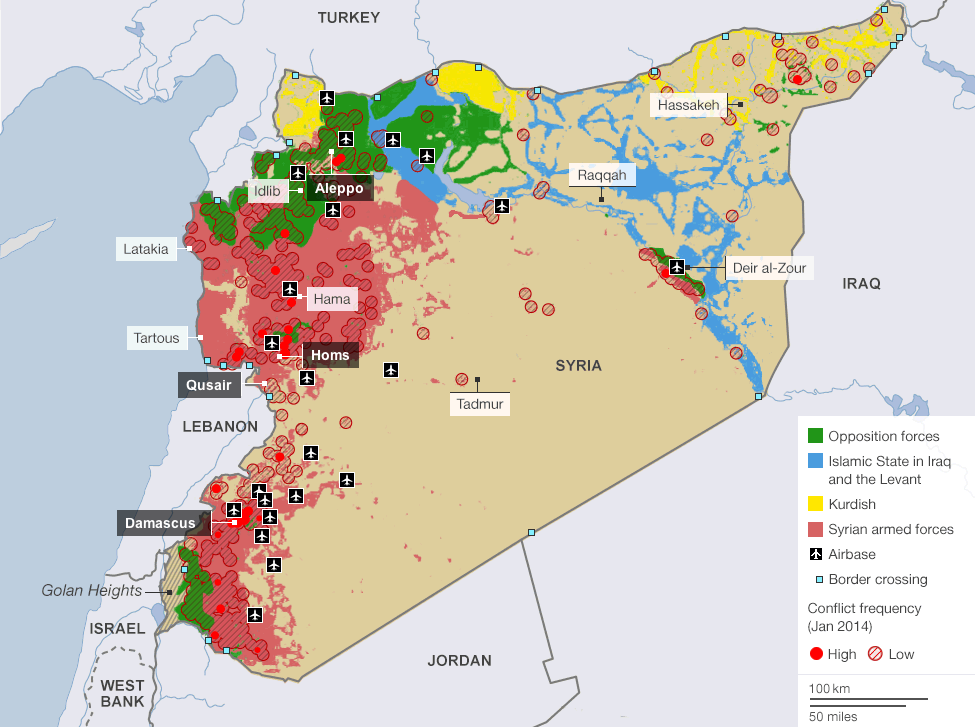

The ISIS Organization
- The Islamic State in Iraq and Syria has a detailed structure that encompasses many functions and jurisdictions.
- Many of its leaders are former officers from Saddam Hussein’s long-disbanded army who augmented their military training with terrorist techniques during years of fighting American troops.
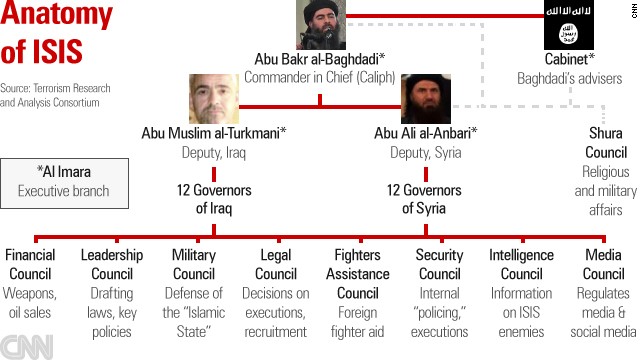
Territory
- ISIS has rapidly expanded its control over Iraq and Syria by seizing towns and cities near major supply routes, critical infrastructure and border crossings.
- Over the summer, the group pressed deeper into Syria, regaining some territory it had lost to other rebel groups and capturing several government military bases. It is still trying to consolidate its control along the border between Iraq and Syria.
- ISIS fighters experienced some setbacks in Iraq, where American airstrikes helped Iraqi and Kurdish forces reclaim the Mosul Dam and the Turkmen city of Amerli.
- ISIS has rapidly expanded its control over Iraq and Syria by seizing towns and cities near major supply routes, critical infrastructure and border crossings.
- Over the summer, the group pressed deeper into Syria, regaining some territory it had lost to other rebel groups and capturing several government military bases. It is still trying to consolidate its control along the border between Iraq and Syria.
- ISIS fighters experienced some setbacks in Iraq, where American airstrikes helped Iraqi and Kurdish forces reclaim the Mosul Dam and the Turkmen city of Amerli.
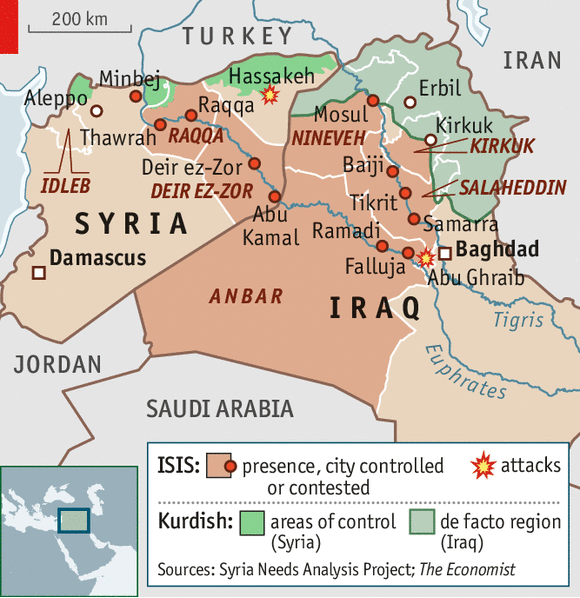
Financing
- Millions of dollars in oil revenue have made ISIS one of the wealthiest terror groups in history.
- Experts estimate the value of the output from the dozen or so oil fields and refineries under its control in Iraq and Syria at $1 million to $2 million a day.
Oil fields Oil fields controlled by ISIS

TURKEY
100 miles
IRAQI
KURDISTAN
IRAN
Mosul
Erbil
Raqqa
Aleppo
Iraq-Turkey
pipeline
Omar
oil field
Kirkuk
IRAQ
Baniyas
Tartus
Baiji oil
refinery
Euphrates
Homs
Tigris
SYRIA
LEBANON
Damascus
Baghdad
Falluja
Rutba
Sources: Brookings Doha Center; Caerus Associates; Energy Information Administration; International Energy Agency; Iraq Oil Report; Platts
- The group controls many of Syria’s eastern oil fields. In July, ISIS fighters took control of the country's largest oil field, Omar, which was producing about 30,000 barrels a day when it was fully functioning. Recently it was producing about a third of that or less.
- ISIS expanded its attacks into Iraq’s oil-producing areas in June, and an August sweep into the Kurdish region gave it access to more of the country’s oil assets.
- Experts estimate that the Iraqi oil fields under ISIS control may produce 25,000 to 40,000 barrels of oil a day — worth a minimum of $1.2 million in the underground market.
Governing
- When it seizes a city, ISIS keeps select services operating while using brute force to impose its vision of a fundamentalist Islamic state.
- Religious police make sure that shops close during Muslim prayers and that women cover their hair and faces in public.
- Public spaces are walled off with heavy metal fences topped with the black flags of ISIS.
- People accused of disobeying the law are punished by public executions or amputations. At the same time, ISIS keeps markets, bakeries and gas stations functioning.

Food distribution near Aleppo.
Distribution of cooking gas in Deir al-Zour.
Destruction of an unapproved religious site.
A member of the ISIS religious police.
Military
- The Central Intelligence Agency believes that ISIS has between 20,000 and 31,500 fighters in Iraq and Syria and estimates that 15,000 of the jihadists are foreign recruits.
Sweden
Russia
Britain
Canada
Germany
Ukraine
Kazakhstan
France
United
States
Turkey
Syria
China
Afghanistan
Tunisia
Iraq
Pakistan
Libya
Morocco
Egypt
Saudi
Arabia
Sudan
Somalia
KEY
Indonesia
50
100
500
1,500 fighters
Australia
Dotted lines represent the low end of a range.
- The largest blocs of foreign fighters come from nearby Muslim countries, like Tunisia and Saudi Arabia. Smaller contingents come from countries as far away and disparate as Belgium, China, Russia and the United States.
Weapons
- ISIS has stolen hundreds of millions of dollars' worth of weapons and equipment from Iraqi and Syrian military installations.
- It has also intercepted supplies en route to Syrian rebel groups from foreign governments.
- Conflict Armament Research, a private firm that investigates arms trafficking, has tracked small arms and rockets used by ISIS that appear to have been provided to other combatants by Saudi Arabia and the United States.

- Among the weapons that Conflict Armament Research examined were M16 and M4 rifles stamped “Property of U.S. Govt.”
- Such weapons are also in the hands of irregular Shiite forces in Iraq, where the United States provided hundreds of thousands of small arms to supportive forces during its long occupation.

Conflict Armament Research found M79 antitank rockets from the former Yugoslavia that were identical to M79 rockets provided by Saudi Arabia to rebels in Syria.
Iraqi civilians displaced by the crisis
By mid-June, the United Nations reported that the fighting in Iraq displaced over 1 million people, or about 3 percent of the country's population. This is a humanitarian disaster — many of these people needed to be settled in makeshift refugee camps in areas unaffected by the fighting. It's also potentially a strategic problem for ISIS. Some experts believe that the mass exodus from ISIS-controlled areas may be a sign that Sunnis are worried about what life under ISIS would be like. The more Sunnis are uncomfortable with ISIS' rule, the more ISIS should be afraid — ISIS cannot hold territory if Sunni civilians begin cooperating with the Iraqi government or government-aligned militias.

A hypothetical re-drawing of Iraq and Syria
This is an old idea that gets new attention every few years, when violence between Sunnis and Shias reignites: should the arbitrary borders imposed by European powers be replaced with new borders along the region's ever-fractious religious divide? The idea is unworkable in reality and would probably just create new problems. But, in a sense, this is already what the region looks like. The Iraqi government controls the country's Shia-majority east, but Sunni Islamist extremists have seized much of western Iraq and eastern Syria. The Shia-dominated Syrian government, meanwhile, mostly only controls the country's Shia- and Christian-heavy west. The Kurds, meanwhile, are legally autonomous in Iraq and functionally so in Syria. This map, then, is not so much just idle speculation anymore; it's something that Iraqis and Syrians are creating themselves. One of the major questions facing Iraq, perhaps even bigger than the question of whether it can put down ISIS, is whether the government can overcome these sectarian divisions and make Sunnis, Shias, and Kurds feel that they are part of the same Iraqi state. Until Iraqis believe in that project of a diverse, inclusive nation, and until the Iraqi government is able and willing to see it through, conflict is likely to continue.
